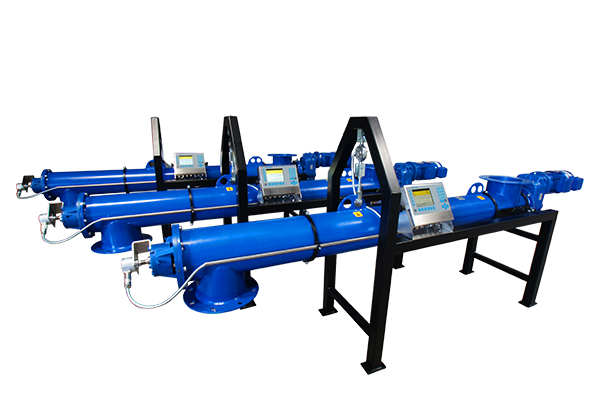Weighing Screw Conveyor
The dust-tight weighing solution
We work with you to optimise the operation of your plant and the measurement of your bulk products

Immediate advice: +49 (0) 29 61 – 96 56 86
The added value to you
Expandable
Precise
Safe
Fast
Why is the weighing screw conveyor the right choice for my plant?

With the benefit of our many years of experience we help you to select the right equipment for your system.
+49 (0) 29 61 – 96 56 86
You are probably familiar with the following situation:
You need continuous flow measurement and would like to use existing equipment
Your product can (only) be conveyed by screw conveyors and requires a closed system.
You do not have sufficient structural height to install other solid flow measure systems like impact meter or intakes scales.
The ideal solution:
Screw conveyors are closed, dust-tight systems, which transport even difficult products reliably.
A weighing screw conveyor measures the actual material flow and the absolute during the material is conveyed.
A weighing screw conveyor can used for new-built facilities and sometimes be retrofitted for existing screw conveyors.
Upon request, we will gladly send you a series of information about our products, starting with the access to our data sheets.
How does the weighing screw conveyor work?
The screw is supported on the drive side in a maintenance-free flexure. The material is fed in symmetrically to this swivel joint; therefore, the impulse forces generated by the material feeding have only a very slight effect on the weigher. On the output side a precision tension load cell ensures that the load is weighed exactly.
The electronic unit standardises the load cell weight signal and links it to the rotation speed, which is measured by a maintenance-free, incremental rotary encoder. The product of rotation speed and net weight thus corresponds to the flow rate in kg or t per hour.
It is important that the screw conveyor is completely uncoupled from the input and the output side. For this reason the weighing screw conveyor must be feed via a rotary valve or a second screw.
To prevent that the product is „thrown over“, the screw should be filled to a defined degree only. Furthermore, the screw volume (length and cross-section of the screw) must remain in sensible relationship with the tare-weight. A longer screw is frequently required for low product densities and low flow rates.
Usually Hense Wägetechnik supplies the weighing technology components and the screw convyor is provided by customer.
Technical data
Flow rate:
from 10 t/h, in some cases from 2.0 t/h on, minimum flow rate depends on several factors like length of screw, bulk density, etc.
Grain size range:
0 – 40 mm
Product density range:
from 200 kg/m³
Sensor:
C3 / Stainless Steel
Supply:
5 – 15 VDC
Sensor protection class:
IP68
System accuracy:
typically 5 – 10%
Electronics
Colour graphic display, kg/h or t/h,
kg absolute or t absolute
Supply:
110 – 240 VAC / 12 – 30 VDC
Input:
Full Bridge Strain Gauge Sensors / inputs for tare and start batch, etc.
Output:
Counting pulses (kg/t)
Optional:
4-20 mA / RS232/485 / Profibus DP /
Profinet / Modbus / Batching contact / etc.
Enclosure:
Stainless steel
Type of protection:
IP67
Type of mounting:
Wall- or Panel mounting
Working temperature Range:
-10°C to +40°C
Frequently asked questions
What levels of accuracy can be obtained with weighing screw conveyors?
The typical measurement error for a weighing screw conveyor lies between 5 and 10 % when considering the recommendations for weighing screw conveyors.
How can the accuracy of a weighing screw conveyor be improved?
The accuracy of a weighing screw conveyor depends on many factors. Firstly, the weight of the product in the screw must be in a certain ratio to the weight of the screw conveyor itself. Moreover, inlet and outlet must be mechanically de-coupled by flexible compensators. Suction connections, as well as the positive or negative pressure require ventilation, since otherwise tensile or compressive force shunts will affect the weighing result.
The filling degree of the screw must not exceed 40%, depending on the product and the screw rotation speed. For automatic calibration, in many applications we place a weighing container in front of the screw intake to regularly check and correct the tare load of the screw conveyor.
Only tube screw conveyors should be used for weighing applications. Trough screw conveyors are not suitable systems.
What measuring ranges can be covered?
Depending on the product and the screw length, mass throughputs of 10 t/h up to 500 t/h can be recorded.
For what applications are screw weighers used?
What interfaces are possible and what data is transmitted?
What are the limitations of the system?
A screw weigher becomes too inaccurate for very small mass flows significantly below 2000 kg/h.
In addition, the measurement principle is not suitable for precise batch dosing processes or balancing.
Is calibration of the system necessary?
It is difficult to calibrate a screw weigher mathematically. Therefore, comparison with a known quantity must always be carried out. It is recommended to plan the calibration process, when planning the use of a weighing screw conveyor.
